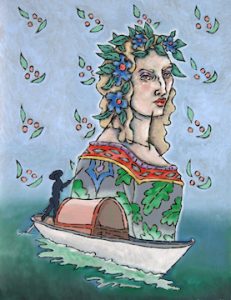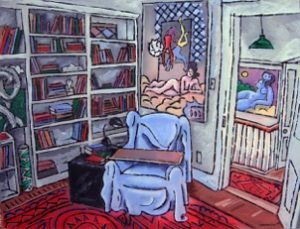Paul Harmon: A Sense of Harmony in Two Places
In new dual exhibitions, Paul Harmon’s endless creativity and design aesthetic is highlighted in paintings, on paper, and in objets d’art during “Paul Harmon: A Sense of Harmony in Two Places.” A carefully curated selection of Harmon’s paintings from the length of his career will soon be on view at Dane Carder Studios at Houston Station in Nashville. Simultaneously, Harmon’s works on paper and his rarely seen objets d’art debut at Haynes Galleries in Franklin. Both exhibitions open October 26 and continue until November 24. An opening reception to celebrate both shows will take place at Dane Carder Studios in Houston Station on Friday October 26, from 6pm to 9pm. The reception and exhibitions are open to the public.
While presented in tandem, each exhibition presents a different facet of Paul Harmon’s artistic output. The paintings portion of “Paul Harmon: A Sense of Harmony in Two Places” covers the depth and breadth of Harmon’s paintings. Curated by artist Dane Carder, it explores the most common threads of Harmon’s painting from his long and fruitful career. There are scenes from every genre— landscapes, interiors, still lifes, and figurative scenes— but all maintain Harmon’s compositional savvy, bold palette, and trademark graphic line quality. “There is a certain sense of harmony” to all the artworks, notes Carder, adding “I wanted to show paintings that felt like they could express the essence of particular periods or series of Paul’s work, spanning decades, but all unmistakably inspired by the same source.”
Concurrently at Haynes Galleries in Franklin, the works on paper and small works portion of the exhibition shines a light on the artworks not many Harmon fans have seen before. Gary R. Haynes, who conceived of the multi-venue exhibition concept says, “Paul is so versatile and is comfortable working two-dimensionally as well as three-dimensionally. He puts his signature look and feel on everything from over-sized lithographs to artful utility ceramics to unique and compelling sculptures.”
On paper Harmon works primarily in enamel and acrylic, lending each a painterly quality but with a different effect in the finished piece. In design, Harmon has taken a slightly more simplified approach than in his larger paintings. There are portraits and still lifes with monochromatic or nondescript backgrounds. Harmon’s objets d’art bring the bold, graphic designs of his paintings into three dimensions. A mix of ceramics formed by Harmon’s own hands, wood sculptures, and painted found objects, this collection reveals the depth of Harmon’s artistic proclivities and the versatility of his aesthetic.
Whether seen together or seen apart, the two new Paul Harmon exhibitions illuminate the harmonious nature of Harmon’s artistic output over several decades. He’s worked in all kinds of media and most every genre but a strong sense of design, a distinctive emphasis on line, and experimentation with picture planes have been mainstays. When you’re looking at a Paul Harmon, you know you’re looking at a Paul Harmon. It might not seem like the one next to it, but it features many of the same elements, tweaked to explore some new idea or shatter expectations.




